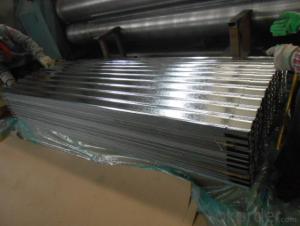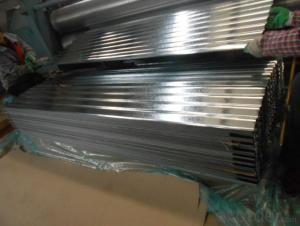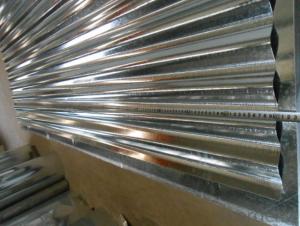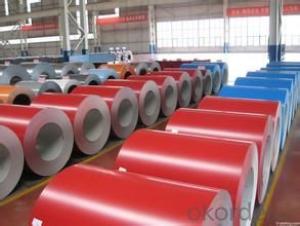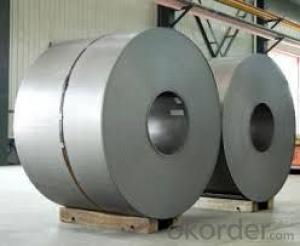Corrugated Hot Dipped Galvanized Steel-Sheet
- Loading Port:
- Shanghai
- Payment Terms:
- TT OR LC
- Min Order Qty:
- 50 m.t.
- Supply Capability:
- 2000 m.t./month
OKorder Service Pledge
OKorder Financial Service
You Might Also Like
Description:
Corrugated sheet is a high strength and durable steel, mostly used for architectural decoration. We have scores of corrugated sheets production lines of different types, producing profiled sheets of all kinds of types and colors. Since it adopts high strength steel sheet and the dimension is designed reasonably, the corrugated sheets are widely used on roofs and walls of various buildings, which can be easily installed, be flexible and changeable, unrestricted by no factor of the buildings.
Pressing steel panel can be freely incised, it can satisfy the especially designing demands. It apply on convenient construction, and anti-seismic performance, fire proof, waterproof, .
Base sheet : galvanized steel sheet, pre painted galvanized steel sheet
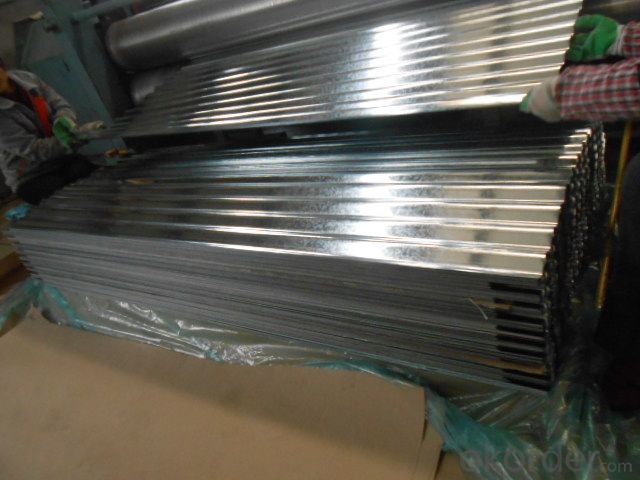

Application:
It has been widely applied on civil construction like storerooms, special building roof and walls of wide-span steel structure building and so on.
Pressing steel panel with the clear line, and many colors for choice, suitable for any different building style materials, achieving satisfy effects;
Product Specification:
Thickness tolerance: (+/-0.01mm)
Zinc coating: 50-180g/m2
Standard:jis g 3302, SGCH
Package: 3 ton/pallet
Specs: 0.14-0.8mm x 900mm x 2000mm
Width:700-1250mm(900mm,1215mm,1250mm,1000mm the most common)
Surface:regular/mini/zero spangle, chromated, skin pass, dry etc.
Package:Standard seaworthy export packing
FAQ:
1. Do you have pallets for the package?
Yes, we must use pallets for the package in order to load.
2.How many pieces for one package?
The pieces for one tone is decided by the thickness of the sheet, but we can make it according to your requirements in the reasonable range.
3. Could you produce the sheets according to our design?
Yes, we can make it.
- Q:What is the average thickness tolerance for steel sheets?
- The specific grade and manufacturing process can cause the average thickness tolerance of steel sheets to vary. Nonetheless, the industry standard for cold-rolled steel sheets is typically ±0.005 inches (0.13 mm) for sheets up to 36 inches wide, and ±0.010 inches (0.25 mm) for sheets wider than 36 inches. In the case of hot-rolled steel sheets, the average tolerance is usually higher and ranges from ±0.010 inches to ±0.060 inches (0.25 mm to 1.52 mm) depending on the sheet's thickness and width. It is worth noting that these values are averages, and manufacturers may establish their own tolerances based on customer demands and production capabilities.
- Q:What is the impact resistance of steel sheets?
- The impact resistance of steel sheets is generally high due to the material's inherent strength and durability. Steel sheets can withstand heavy impacts without deforming or breaking, making them suitable for various applications where protection against impact or force is crucial.
- Q:How do you join two steel sheets together?
- One common method to join two steel sheets together is welding. Welding involves melting the edges of the steel sheets and fusing them together using a welding machine and a filler metal. This creates a strong and durable bond between the two sheets. Other methods include using fasteners such as bolts, screws, or rivets, and using adhesives specifically designed for steel bonding. The choice of joining method depends on factors such as the application, desired strength, and aesthetics.
- Q:Can steel sheets be used for storage shelves?
- Yes, steel sheets can be used for storage shelves. Steel is a durable and strong material that can provide sufficient support and stability for storing items on shelves.
- Q:Can steel sheets be used for walkways or platforms?
- Certainly! Walkways or platforms can be constructed using steel sheets. Steel sheets are frequently employed in industrial and commercial settings owing to their durability, strength, and ability to withstand diverse environmental factors. They can be fabricated and installed to establish robust walkways or platforms capable of enduring heavy pedestrian traffic or the movement of equipment and machinery. Steel sheets can also be customized to fulfill specific design requirements, such as incorporating non-slip surfaces, raised edges for safety, or perforations for drainage. Furthermore, steel sheets necessitate relatively minimal upkeep and can be effortlessly cleaned and maintained, making them a perfect choice for walkways or platforms in various applications, including factories, warehouses, construction sites, and even outdoor areas.
- Q:Are steel sheets suitable for railway infrastructure?
- Railway infrastructure can benefit greatly from the use of steel sheets. Steel is a popular choice for constructing railway infrastructure because it is strong, durable, and versatile. One of the main advantages of steel sheets in railway infrastructure is their high strength-to-weight ratio. Steel is exceptionally strong, allowing it to handle heavy loads and provide long-lasting support to railway tracks, bridges, and other structures. This strength is crucial for the safety and stability of the railway system, especially when dealing with the weight and impact forces exerted by trains. Furthermore, steel sheets offer excellent durability and resistance to wear and tear. Railway infrastructure is constantly exposed to stress, including vibrations, impacts, and extreme weather conditions. Steel's inherent properties make it highly resilient to these factors, reducing the need for frequent repairs and maintenance. This durability leads to significant cost savings in the long run, as steel structures have a longer lifespan compared to other materials. In addition, steel sheets are highly versatile and can be easily shaped and sized to meet specific railway infrastructure requirements. This flexibility allows for the efficient construction of rails, sleepers, bridges, and other components necessary for a functional and safe railway system. Steel's adaptability also enables easy modifications and expansions to the infrastructure as needed, ensuring compatibility with changing transportation needs. To summarize, steel sheets are an excellent choice for railway infrastructure due to their strength, durability, and versatility. Their high strength-to-weight ratio, resistance to wear and tear, and ease of fabrication make them ideal for constructing and maintaining railway tracks, bridges, and other structures. The use of steel in railway infrastructure guarantees the safety, efficiency, and longevity of the railway system.
- Q:What is the standard size of steel sheets?
- The standard size of steel sheets can vary depending on the specific application and industry. However, a common standard size for steel sheets is typically around 4 feet by 8 feet.
- Q:What is the hardness of the steel sheets?
- The specific grade and treatment of steel can cause variations in the hardness of steel sheets. The Rockwell hardness scale is commonly used to measure the resistance of steel sheets to indentation. The hardness of steel sheets can vary greatly, ranging from soft to extremely hard, and is influenced by factors like carbon content, alloying elements, and heat treatment methods employed in manufacturing. When choosing steel sheets, it is crucial to consider the intended application and desired properties, as the hardness can impact wear resistance, strength, and machinability.
- Q:Can steel sheets be used for soundproofing purposes?
- Yes, steel sheets can be used for soundproofing purposes. Steel is a dense and rigid material that effectively blocks the transmission of sound waves. When used in soundproofing applications, steel sheets can help reduce the amount of sound that passes through walls, floors, or ceilings. They can be installed as a barrier or added as an additional layer to existing structures to increase their soundproofing capabilities. However, it is important to note that steel sheets alone may not provide complete soundproofing, as sound can still travel through other pathways such as windows or doors. Therefore, a comprehensive soundproofing strategy may involve combining steel sheets with other sound-absorbing materials, such as acoustic foam or insulation, to achieve optimal results.
- Q:How are steel sheets protected during shipping?
- To guarantee the secure delivery of steel sheets, numerous measures are taken to protect them during shipping. One commonly used technique involves using packaging materials like cardboard or wooden crates, specifically designed to securely hold the steel sheets in place and reduce the risk of movement or potential damage during transit. Furthermore, steel sheets may also be shielded from moisture, dust, and other environmental factors by applying a protective coating or wrap. This can take the form of a thin layer of oil, wax, or a specialized rust inhibitor, acting as a barrier against corrosion. To enhance protection even further, steel sheets are often stacked and fastened with strapping or banding materials. These measures ensure that the sheets remain in a fixed position and do not shift during transportation, preventing any potential impact or friction that could cause damage. Additionally, shipping companies implement special handling procedures to minimize the risk of harm. This involves utilizing equipment such as forklifts or cranes to carefully load and unload the steel sheets, avoiding any rough handling or accidental drops that could result in dents or bends. In conclusion, a combination of appropriate packaging, protective coatings, secure strapping, and careful handling guarantees the adequate protection of steel sheets during shipping. This comprehensive approach minimizes the possibility of any damage occurring and ensures that the sheets arrive in optimal condition at their intended destination.
1. Manufacturer Overview |
|
|---|---|
| Location | |
| Year Established | |
| Annual Output Value | |
| Main Markets | |
| Company Certifications | |
2. Manufacturer Certificates |
|
|---|---|
| a) Certification Name | |
| Range | |
| Reference | |
| Validity Period | |
3. Manufacturer Capability |
|
|---|---|
| a)Trade Capacity | |
| Nearest Port | |
| Export Percentage | |
| No.of Employees in Trade Department | |
| Language Spoken: | |
| b)Factory Information | |
| Factory Size: | |
| No. of Production Lines | |
| Contract Manufacturing | |
| Product Price Range | |
Send your message to us
Corrugated Hot Dipped Galvanized Steel-Sheet
- Loading Port:
- Shanghai
- Payment Terms:
- TT OR LC
- Min Order Qty:
- 50 m.t.
- Supply Capability:
- 2000 m.t./month
OKorder Service Pledge
OKorder Financial Service
Similar products
New products
Hot products
Hot Searches
Related keywords
